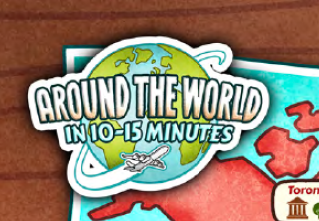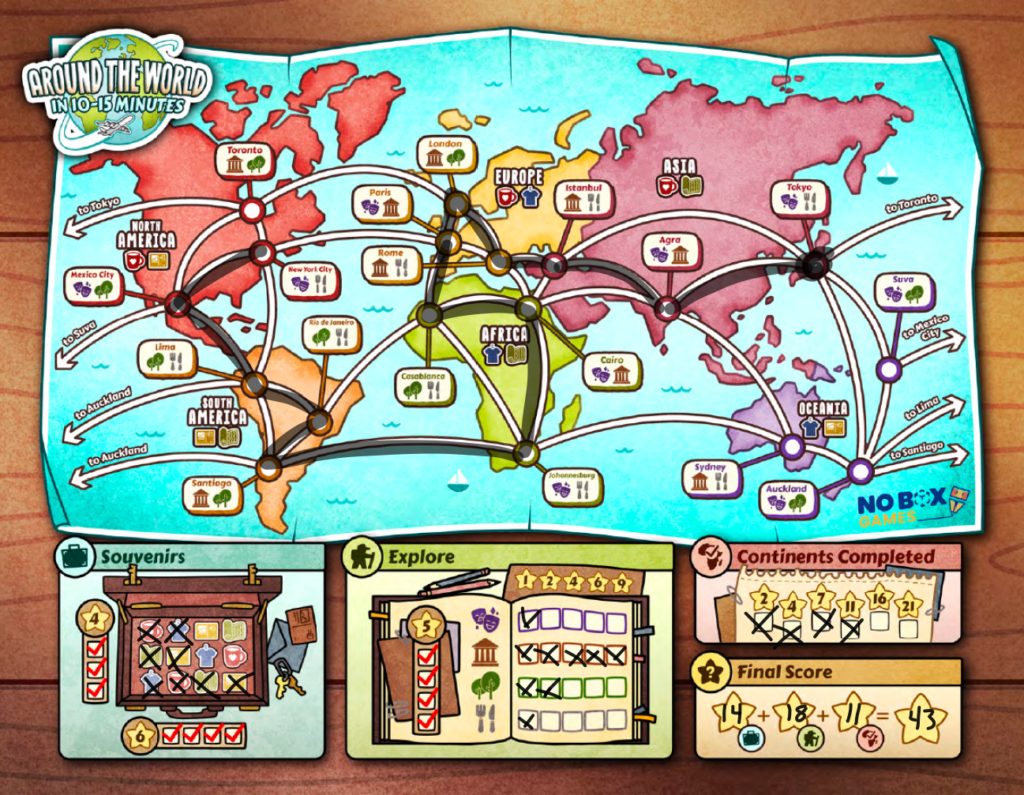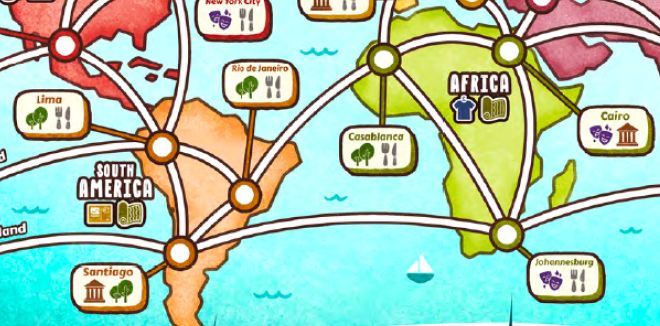Unplugged: Around the World in 10-15 Minutes (Boardgame)
 The Roll and Write genre, where gamers roll dice and use the results to fill in a scorepad, continues to gain momentum. I suspect this is due in part to the low cost of entry. This is particularly true for print and play games. If standard dice are used, all that players need is a printed copy of the scorepad. Variations have appeared over the years, including using a deck of cards to make a Flip and Write game. Around the World in 10-15 Minutes eschews both dice and cards to allow the active player to choose the result for the turn, effectively creating a Choose and Write game. The game sheet consists of a map of the world connected by lines with two icons located on each continent and two on each city. The active player chooses whether everyone moves, marks off a continent icon, or marks off a city icon, with the active player gaining the selected benefit twice. All three choices lead to scoring opportunities and the game runs until one player has visited each continent and returned to their starting city. Points are added and a winner is determined. Since there are no dice or cards involved, the game only requires one maker and one scorecard per player – making it even more travel-friendly. Around the World in 10-15 Minutes is a print-and-play title currently up on Kickstarter until May 30th.
The Roll and Write genre, where gamers roll dice and use the results to fill in a scorepad, continues to gain momentum. I suspect this is due in part to the low cost of entry. This is particularly true for print and play games. If standard dice are used, all that players need is a printed copy of the scorepad. Variations have appeared over the years, including using a deck of cards to make a Flip and Write game. Around the World in 10-15 Minutes eschews both dice and cards to allow the active player to choose the result for the turn, effectively creating a Choose and Write game. The game sheet consists of a map of the world connected by lines with two icons located on each continent and two on each city. The active player chooses whether everyone moves, marks off a continent icon, or marks off a city icon, with the active player gaining the selected benefit twice. All three choices lead to scoring opportunities and the game runs until one player has visited each continent and returned to their starting city. Points are added and a winner is determined. Since there are no dice or cards involved, the game only requires one maker and one scorecard per player – making it even more travel-friendly. Around the World in 10-15 Minutes is a print-and-play title currently up on Kickstarter until May 30th.
Around the World in 10-15 Minutes
Publisher: No Box Games
Players: 2-6
Ages: 14+
Time: 10-15 min (surprise!)
(preview copy provided by publisher)

The flow of the game
To start, each player selects their home city and then the game begins. The active player chooses one of three options: movement around the map, collecting souvenirs from their current continent, or exploring the sites of their current city. The active player gets to do the chosen selection an additional time (two moves, two souvenirs, two explorations). At the end of the game, points are awarded for each of the three categories.

- Movement – when moving, a player draws a line from their current city to any adjacent city. (Two lines if you’re the active player.) Players can move along previously marked routes, but must be sure to keep track of their new location. Movement provides points in two ways. When a player visits each continent and returns to their starting city, the end-game is triggered. The round finishes (everyone gets the same number of turns as the active player) and any player who made it back to their starting city earns bonus points. At the end of the game, players earn points based on how many continents are completely explored. Each continent has three cities and if all three are visited, the continent is considered explored.
- Souvenirs – If souvenirs are selected, each player marks off one (two if the active player) of the souvenirs displayed on their current continent. These are displayed in a 3×4 grid made up of three copies of four different souvenirs. Players earn points for completely filling rows (6 points) and columns (4 points) at the end of the game.
- Exploration – When exploration is selected, players mark off one (or two) check boxes corresponding to the exploration icons in their current city. At the end of the game players will score for sets of one of each of the four icons (5 points) as well as scaled scoring for each type (1,2,4,6,9 points for 1 to 5 of each exploration type.)
The game ends once someone has made the journey through every continent and returned home and every player has had the same number of active turns. Everyone who made the complete circuit receives bonus points (even if they later move away from their starting city.) Points are scored and a winner is declared. Ties are broken in favor of the player who ends closest to their starting city.
In addition to the world map, there are score pads for the US and Europe which score the same as the World map but with some additional scoring options. The US map has four special locations (Alaska, Hawaii, Puerto Rico, Washington DC) that are a bit harder to visit and points are scored based on how many of these special cities were visited. The European map has regions with four or five cities. Points are not scored for completely visiting a region. Instead, the player who has visited the most cities in a specific region scores points. If tied, all tied players earn a slightly reduced number of points.
Verdict:
The innovation here is the removal of any form of randomization. One could think of it as a Roll and Write where the active player decides the “rolled” result. One’s opinion of the game will depend on how well they think that works. It certainly makes the game extremely portable, since no dice or cards are needed for the Roll/Flip portion of this style of game. Players stay engaged throughout the game, since everyone gains something each turn. Since the active player gets a double-benefit, that choice will be the primary way for players to differentiate their score.

The scoring is what is going to make or break the game for most people. The scoring is set up to favor specialization in a particular aspect of the game. In my experience, the souvenirs and explorations generate more points than moving around to completely visit continents. Of course, some movement is needed – as staying in one place (or one continent) will only provide access to the same two options. This can be advantageous for explorations, but players chasing souvenirs will need to be moving between continents. This works as acquiring all the souvenirs is worth slightly more points than the equivalent number of explorations. For a game about traveling around the world, I’d like to see the movement portion of scoring providing a greater portion of the scoring. Unless several players push for quick movement and a short game, players focusing on collecting souvenirs and explorations will typically out-score players with a heavier movement emphasis. It isn’t game-breaking, but first timers should be given a heads-up.
I like that the game currently has three maps, as they accomplish what any expansion/option is expected to provide. The other two maps have all the same mechanics, but with just enough spin on the rules to force players to make adjustments – they can’t just go with the same strategy that worked on the World Map.
My final verdict falls under two main points. I love that this is a Roll and Write with no rolling. The extreme portability means that I can play this sitting in a car or airplane – or even waiting in line somewhere. If everyone has a score pad and a pencil (or laminated pad and dry erase marker) the game is ready to go. The second part of my evaluation comes into play with player count. At high player counts, player agency is more limited. There could be 4 or 5 actions taken before a player gets to take a double-action of their choice. While that means that players have to keep their options more open as they go, it also reduces the feeling of control within the game.
As mentioned, Around the World in 10-15 Minutes is a print and play game, currently available on Kickstarter until May 30th. Fans of the genre should check it out, as the price is right for a rather unique example of the genre.
Kid Factor
With no text to worry about, this is a great game for the younger set. With only three choices available to the active player, the complexity is kept rather low. Since the game doesn’t even use dice or cards – only the score pad – the game is great for road trips, when space is at a premium. The game works with any kid that has enough attention span to play through a game – although they may need help adding up their scores.





Discussion Area - Leave a Comment